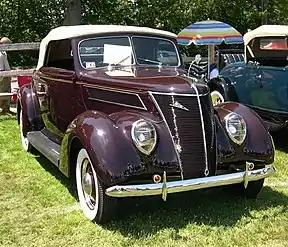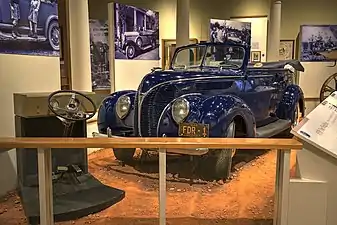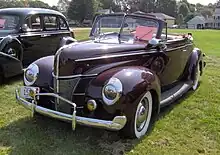| 1937 Fords | |
|---|---|
 1937 Ford convertible | |
| Overview | |
| Manufacturer | Ford |
| Production | 1937–1940 |
| Assembly | Atlanta, Georgia Chester, Pennsylvania Chicago, Illinois Long Beach, California Dearborn, Michigan Bucharest, Romania |
| Body and chassis | |
| Class | Full-size Ford |
| Body style | 2-door coupe 2-door convertible 2-door 1-ton pickup truck 2-door sedan 2-door station wagon 2-door van 4-door sedan 4-door station wagon (Woodie) 2-door coupe utility (Australia)[1] 2-door roadster utility (Australia)[1] |
| Layout | FR layout |
| Powertrain | |
| Engine | 136 CID (2.2 L) Flathead V8 221 CID (3.6 L) Flathead V8 |
| Transmission | 3-speed sliding-mesh manual |
| Dimensions | |
| Wheelbase | 2,845 mm (112.0 in) |
| Chronology | |
| Predecessor | Ford Model 48 |
| Successor | 1941 Ford Ford Pilot (for models assembled in the UK)[2] Ford Vedette (for models assembled in France) |
The Ford line of cars was updated in 1937 with one major change — the introduction of an entry-level 136 cu in (2.23 L) V8 in addition to the popular 221 cu in (3.62 L) flathead V8. The model was a refresh of its predecessor, the Model 48 (itself based on the Model 40A) and was the company's main product. It was redesigned more thoroughly in 1941. At the start of production, it cost US$850 ($17,303 in 2022 dollars[3]). The Ford Line bore several model numbers during this period, each related to their respective HP numbers. In 1937, 85 HP cars were known as Model 78 while 60 HP cars were known as Model 74. This changed to Model 81A and 82A respectively in 1938, and Models 91A and 92A in 1939.
1937

The 1937 Ford featured a more rounded look with fine horizontal bars in the convex front and hood-side grilles. The front grille was V-shaped, rather than following the fenders into a pentagon shape, as on the 1936 model. Faired-in headlights installed in the front fenders were a major modernization found on both the Standard and DeLuxe trim versions, and the introduction of an all steel top for the passenger compartment. The Standard could be distinguished from the DeLuxe by the body color radiator grilles and windshield frames while the DeLuxe had walnut woodgrain window mouldings and exterior trim brightwork, and a woodgrain finish applied to the interior window trim.[1] A larger water pump was used to help aid in cooling.[4] 'Slantback' sedans gained a rear trunk door, though space was limited, and 'Trunkback' versions continued gaining sales. The station wagon had seating for eight passengers. A 4-door "convertible sedan" with roll up windows was offered in small numbers in the DeLuxe series.[5] Also, new seats were used.[6]
1938
The 1938 recession hurt sales, as did Ford's continuing of the 1937 cars, including most body panels. 1938 DeLuxe models were differentiated with a heart-shaped grille, though standard models retained the 1937 look. The fading Slantback sedan design was cancelled for good. Only a V8 was offered, either a 60 hp (45 kW; 61 PS) V8 or an 85 hp (63 kW; 86 PS) V8.[7] A new dash was used, with recessed controls for safety.[7]
The 1938 trucks were finally updated, having continued with 1935 looks. Changes included a vertical oval grille and substantial fenders and bumpers.
 Latvian-assembled 1938 Ford Deluxe Fordor sedan
Latvian-assembled 1938 Ford Deluxe Fordor sedan 1938 Ford on display at the Little White House
1938 Ford on display at the Little White House
1939
.jpg.webp)
The Ford's look was again modernized for 1939 — the Deluxe used a low pointed grille with heavier vertical slats, while the standard Ford had a higher grille with horizontal dividers. The headlights (the example illustrated has been converted to '40 Ford sealed beam headlamps - '39s used bulb and reflector lamps, the last year for them) were moved farther apart, sitting almost in front of the wheels. The side grilles and louvers were removed in favor of chrome strips on Deluxe models. The "alligator" hood opened deep from the top of the grille back, eliminating the side panels found on previous models.
Mechanically, Ford put hydraulic brakes on their cars for the very first time.[8][9]
The phaeton, club coupe, and convertible club coupe models were discontinued. The engine was also revised for 1939 with downdraft carburetors widening the torque band but leaving power unchanged at 85 hp (63 kW). Hydraulic brakes were a major advance across the Ford line.
Ford's upscale Mercury line also made its debut in 1939, filling the gap between the Deluxe Fords and the Lincoln-Zephyr line.
1940
 1940 Ford Deluxe Convertible Club Coupe |
_front.jpg.webp) 1940 Ford Standard Business Coupe |
A high flat-topped hood dominated the front look of the 1940 model, as the grille spread out to reach the fenders to differentiate the Deluxe line and the headlights were pushed wider still. The standard Ford inherited the grille of the 1939 model with blackout on each side of a heavy chrome center; heavier headlight surrounds serve as another major differentiator from the 1939. 1940 was the last year of the 1937 design and its smaller V8 engine, with a straight-six engine to be reintroduced the following year. Sealed-beam headlights were one of the few major advances for 1940, while a hydraulic top was new on the convertible.
Legacy
The 1937-1940 generation of Fords is one of the most popular automobiles for hot rodding. Early stock car racing drivers also used Fords of this generation among other cars. This Ford also formed the basis for a style of dirt track racing car.
Ford was building cars in France since 1916. The company was formed in Bordeaux as Société Française des Automobiles Ford in 1916 by Percival Perry, the head of Ford of Britain. After 1925, assembly was redirected at a workshop in Asnières-sur-Seine near Paris. The company assembled the Ford Model T and then it's successor models, the Model A and the Model B. In 1934 Maurice Dollfus, the head of Ford Société Anonyme Française (SAF), was looking for a larger manufacturing plant and reached an agreement with Emile Mathis to enter into a joint venture with the Mathis company forming Matford in Strasbourg and Asnières. The new company name was Matford SA. Ownership was split 60%/40% with Ford having the larger share. Since 1935, American Ford V8s would be badged as Matfords for the French market, with a choice of a 2,225 or 3,621 cc V-8 engine. The 1937 models were generally known at the time simply as the Matford 13CV and the Matford 21CV which followed the convention of the time by using the cars' fiscal horse power ratings as model names. Production of passenger cars there ended in 1940. After the war, the old 2,225 cc V8-engined Matford model was relaunched to the market in a modernized version, with the Ford F-472 name. It was later renamed the F-472A and continued being produced until 1948, when it was replaced by the Ford Vedette, which was an almost completely new car, and only shared it's engine with the previous vehicle. This engine went on to be used in the Simca Vedette, and later the Simca Esplanada, until 1969.[10] The Ford V8 was also produced locally in the United Kingdom until the Second World War. After the war, it was re-styled and modernized as the Ford Pilot, production continued until 1951.
See also
Sources
- 1 2 3 1938 Ford V8 Utility Sales Brochure, www.ebay.com.au, as archived at web.archive.org
- ↑ Geoghegan, Simon. "Ford V8 Pilot". Simon Cars. Retrieved 2 April 2015.
- ↑ 1634–1699: McCusker, J. J. (1997). How Much Is That in Real Money? A Historical Price Index for Use as a Deflator of Money Values in the Economy of the United States: Addenda et Corrigenda (PDF). American Antiquarian Society. 1700–1799: McCusker, J. J. (1992). How Much Is That in Real Money? A Historical Price Index for Use as a Deflator of Money Values in the Economy of the United States (PDF). American Antiquarian Society. 1800–present: Federal Reserve Bank of Minneapolis. "Consumer Price Index (estimate) 1800–". Retrieved May 28, 2023.
- ↑ Weiss, H. Eugene (2003). Chrysler, Ford, Durant, and Sloan. McFarland. ISBN 0-7864-1611-4.
- ↑ "Directory Index: Ford/1937_Ford/1937_Ford_V-8_Wagon_Folder". Oldcarbrochures.com. Retrieved 2012-05-31.
- ↑ "The Old Car Manual Project Brochure Collection".
- 1 2 "Directory Index: Ford/1938_Ford/1938_Ford_Folder". Oldcarbrochures.com. Retrieved 2012-05-31.
- ↑ 1939 Ford Mailer. Ford Motor Company. 1939. Retrieved 28 May 2020.
- ↑ The Editors of Consumer Guide. "1939 Ford Deluxe". Archived from the original on 24 January 2021. Retrieved 28 May 2020.
- ↑ "Matford, l'ancêtre des Vedette". Retrieved 22 December 2023.
- David L. Lewis (2005). 100 Years of Ford. Publications International. pp. 97–110. ISBN 0-7853-7988-6.
- "Generations: Ford Model T to Crown Victoria". Edmunds.com. Archived from the original on 5 September 2006. Retrieved August 21, 2006.
External links
 Media related to 1937 Ford vehicles at Wikimedia Commons
Media related to 1937 Ford vehicles at Wikimedia Commons